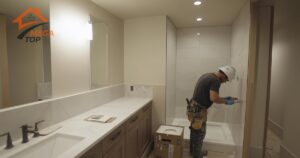INTRO
When it comes to bathroom remodeling, ventilation is one of the most overlooked yet essential elements. Proper ventilation ensures that your bathroom remains fresh, moisture-free, and free from issues like mold and mildew. Without it, even the most stylish remodel can turn into a nightmare of peeling paint, musty odors, and long-term structural damage. At MegaTop™, we’re here to guide you through everything you need to know about bathroom ventilation to keep your remodel functional and comfortable.
Why Ventilation Is a Must in Bathroom Remodeling
Bathrooms are high-moisture areas, and without proper ventilation, that humidity has nowhere to go. Over time, excess moisture can lead to a host of problems:
- Mold and Mildew Growth: These thrive in damp, poorly ventilated spaces and can pose health risks.
- Peeling Paint and Warping Wood: High humidity can damage finishes and materials.
- Lingering Odors: Without adequate airflow, your bathroom won’t feel fresh, no matter how clean it is.
Good ventilation protects your investment and ensures your remodeled bathroom stays in great condition for years.
Signs Your Bathroom Needs Better Ventilation
Not sure if your bathroom’s ventilation system is up to the task? Here are some red flags to watch for:
- Fogged Mirrors: If your mirrors stay fogged for more than a few minutes after a shower, your ventilation system may be underperforming.
- Musty Odors: A persistent mildew smell often points to trapped moisture.
- Peeling Paint or Warped Wood: These signs of water damage are usually linked to poor airflow.
If you’re dealing with any of these issues, it’s time to upgrade your bathroom’s ventilation.
Types of Bathroom Ventilation Systems
1. Exhaust Fans
Exhaust fans are the most common and effective way to ventilate a bathroom.
Benefits:
- Quickly remove humid air and odors.
- Can be equipped with additional features like lighting or humidity sensors.
Placement Tip:
Install your exhaust fan near the shower or tub to maximize efficiency.
2. Window Ventilation
Windows can supplement or replace exhaust fans in some bathrooms, especially those with smaller footprints.
When to Use:
- Ideal for bathrooms with natural airflow access.
- Combine with an exhaust fan for improved humidity control.
Pro Tip:
Use frosted glass for privacy while allowing light and airflow.
3. Inline Fans
Inline fans are installed within the duct system, making them an excellent choice for larger bathrooms or spaces without direct exterior access.
Benefits:
- Quiet operation.
- Flexible installation options.
How to Choose the Right Ventilation for Your Bathroom
Calculate the Fan Size
The size of your exhaust fan matters. Too small, and it won’t clear moisture effectively; too large, and it may waste energy.
Formula to Determine CFM:
Bathroom size (sq. ft.) × 1.1 = Minimum CFM rating.
For example, a 60-square-foot bathroom needs a fan with at least 66 CFM.
Consider Noise Levels
Fans with a sone rating of 1.5 or lower are ideal for quiet operation, so your bathroom stays peaceful and relaxing.
Additional Features to Look For
- Humidity Sensors: Automatically turn the fan on when moisture levels rise.
- Built-in Lighting: Combine airflow and lighting for a sleek, dual-purpose fixture.
Step-by-Step Guide to Installing a Bathroom Exhaust Fan
Tools You’ll Need
- Drill, screwdriver, measuring tape, duct tape, and vent cover.
Step 1: Choose the Location
Install the fan near the shower or tub to capture the most moisture.
Step 2: Cut the Vent Hole
Cut a vent hole in the ceiling or wall that matches the size of the fan’s duct.
Step 3: Connect the Ductwork
Attach the exhaust fan to the ductwork using duct tape for a secure seal.
Step 4: Wire the Fan
Connect the fan to a power source or switch, ensuring compliance with local electrical codes.
DIY vs. Professional Installation: Why Choose MegaTop™
While some homeowners may attempt to install ventilation systems themselves, there are risks involved:
DIY Challenges
- Incorrect installation can reduce efficiency and lead to moisture buildup.
- Electrical work requires compliance with safety codes, which can be complex.
MegaTop™ Advantage
- Expert Precision: Our team ensures fans are installed correctly and perform at their best.
- Compliance and Safety: We handle all electrical work, ensuring your system meets code.
- Tailored Solutions: We recommend the best ventilation system for your space and needs.
Testimonials
- “MegaTop™ helped me fix my bathroom’s ventilation issues—it’s made a huge difference!” — Lisa T., Bel Air South, MD
- “Their team installed a powerful exhaust fan that eliminated mold problems in no time!” — Kevin S., Boulder, CO
- “Thanks to MegaTop™, my bathroom feels fresh and dry every day.” — Juno H., Hampden, PA
Did You Know?
Did you know that proper ventilation can extend the lifespan of your bathroom by preventing structural damage caused by moisture? It’s one of the most critical yet overlooked aspects of remodeling.
TL;DR Summary
- Proper ventilation is essential during bathroom remodeling to prevent mold, moisture damage, and odors.
- Choose the right system, such as exhaust fans, windows, or inline fans, based on your space and needs.
- Calculate the correct CFM rating for your fan, and consider features like humidity sensors.
- Trust MegaTop™ for professional installation to ensure a functional and long-lasting solution.
Get in Touch
Ready to transform your bathroom with a stunning new floor? Contact us today for a free estimate!
Fill out our online contact form 📧 or call by phone 📞 for a fast response.
We’re here to answer your questions, provide expert advice, and guide you through every step of the process. Call us, email us, or fill out our quick online form to get started. Let’s bring your vision to life!
FAQ
Proper ventilation prevents moisture buildup, mold growth, and structural damage, ensuring a healthy bathroom.
Signs include fogged mirrors, musty odors, and peeling paint.
Exhaust fans are the most effective, but inline fans or windows can also work, depending on your layout.
While it’s possible, professional installation ensures efficiency, safety, and compliance with electrical codes.
Clean the fan every 6–12 months to maintain optimal performance.





